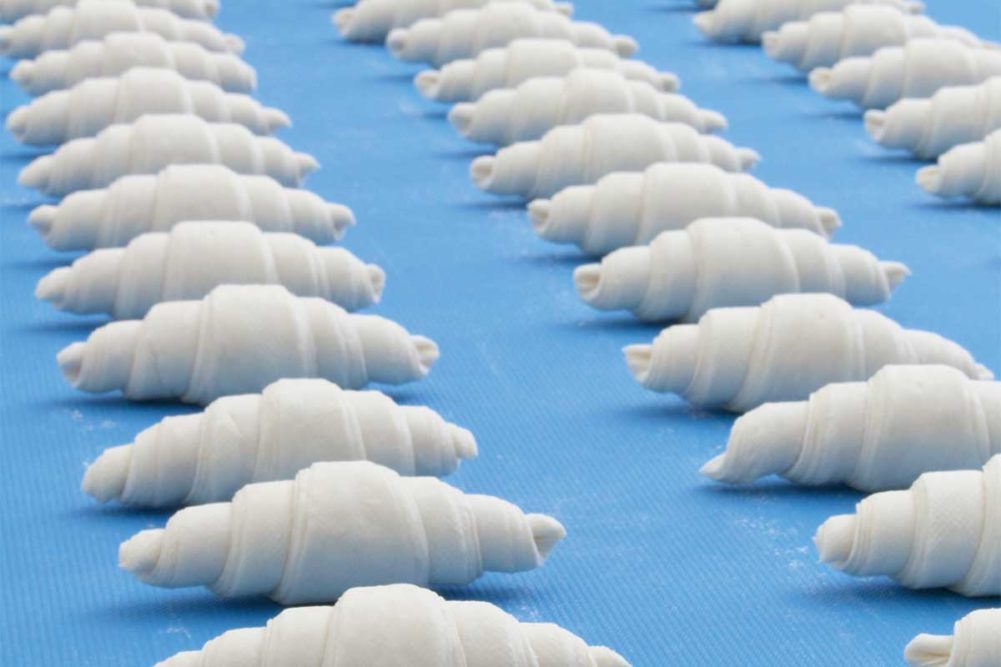Many Americans love a little something sweet in the morning. Hot coffee and a Danish, donut or a chocolate-filled croissant really hits the spot.
Bakers have been busy keeping the shelves stocked with these goodies, especially since the coronavirus (COVID 19) pandemic kept people at home and drove up retail sales. As millions of Americans are still working at home, they are stocking their pantries with these treats.
“Demand for donuts — nearly all varieties — is as strong as ever,” said David Moline, vice president of sales and marketing, Moline Machinery. “Having a system with maximum flexibility to produce a variety of shapes and sizes is very important to meet changing market demands.”
Gentle sheeting, the right temperatures at every stage of the process and the proper handling of fillings all go into the ideal conditions for processing sweet breakfast pastries.
Creating laminated dough can be a tricky process. Success is dependent on careful handling to ensure the layers of dough and fat are maintained.
“When creating the layers in a laminated dough it is very important not to crush or break the layers when you reduce the dough sheet to the final thickness,” said John Giacoio, vice president of sales, Rheon.
“Broken layers allow the fat to leak out during the bake. Rheon offers stress-free lines that will not crush the layers. This means we can actually make fewer layers with our system and still get more oven jump. This also means the final product will be less greasy.”
The butter or margarine used in laminated dough must be evenly distributed, said Randy Kelly, applications specialist, Fritsch, a Multivac Group Company.
“This is done by creating a consistent and continuous layer of fat from our fat pump on top of the dough, creating an even layer prior to the sheeting and laminating stations,” he explained.
Consistency also depends on temperature control, said Alexander Weissbach, head of technology and product management at Rondo. This not only produces a high-quality product, but it also helps bakeries manage costs with proper ingredient handling.
“Dough temperature and especially the room temperature must be kept constant at a certain level,” Mr. Weissbach said. “Working with butter requires lower dough and room temperatures compared to margarine-laminated products. For the laminated products, the laminating fat is the most expensive raw material. Especially today, where raw material prices are increasing dramatically, it is important to keep the exact percentage of the fat ratio.”
Understanding the melting point of the fat being used helps maintain texture in the dough, which is important, said Marion Montillot, product manager bakery and pastry at Mecatherm.
“Folding is a major step in the croissant recipe, so the fat texture must be close to the dough texture to get layers of dough and fat of the same thickness and to obtain a homogeneous and well opened inner crumb,” Ms. Montillot said.
Each pastry product presents its own challenges.
“Yeast rings, for example, can be subject to oval shapes if the product is not gently formed and transferred properly,” Mr. Moline said. “Yeast-raised donuts produced on a sheeting line yield the highest quality product.”
Nick Magistrelli, vice president of sales, Rademaker USA, also stressed the need for gentle handling to maintain donut shape.
“This is accomplished by utilizing the right sheeting components and selecting the right makeup section that ensures a properly shaped donut that has a soft texture,” he said. “Very critical as well is handling the donuts as they transfer from the makeup line to the proofer baskets.”
And when donuts are fried, a stress-free dough will not rip, which means the product will absorb less oil, Mr. Giacoio said.
Ms. Montillot said precision in the proofing and baking stages will produce consistent products.
“Like the folding step, you need to have a precise control of your proofing chamber temperature and humidity,” she explained. “For instance, if the temperature is too high, there is a risk of fat melting, and the number of layers will then decrease.”
Baking a great pastry means that baking temperature and heat transfer modes may need to be adjusted depending on what a bakery is trying to accomplish, Ms. Montillot said. Radiant heat provides color contrast of the different layers, although the sides may not receive the same heat intensity, causing them to be underbaked. Convection heat offers a fast and even heat transfer for the product.
“This is the reason we advise mixing radiant heat and convection to bake croissants in order to keep the typical contrast of color and a stabilized shape,” she said.
This article is an excerpt from the March 2022 issue of Baking & Snack. To read the entire feature on Sweet Goods Processing, click here.






